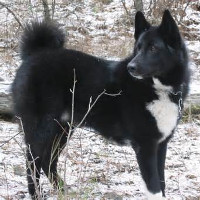 |
Tahltan Bear Dog |
|
He is not recognized by the F.C.I. |
Origin |
Canada | |
Translation |
Francis Vandersteen | |
This breed is also known as |
Chien d'ours Tahltan |
Brief historical summary |
| The Tahltan Bear Dog is a hunting dog native to British Columbia (Canada). Bred by the Indians, this small dog was used to hunt brown bear, grizzly bear, lynx and even porcupine. The Indians held him in high esteem and treated him with deference, going so far as to carry him in a sack thrown over their shoulder so he wouldn't tire. They wouldn't let him go until they'd picked up a trail. Whatever the case, and despite the research undertaken, it would appear that this dog is now one of the extinct breeds. |
General appearance |
| These are alert, lively little hunters of light build. It is longer than it is tall, and wears a ruff or crop. The coat is also erect on the forelegs (breeches) and brush-like on the tail, which is short and straight. Bold, independent and wily, these dogs are easy to train. They are loyal and devoted to their master, but wary of strangers. |
Head |
||
Cranial region |
||
Head |
Reminiscent of a fox. | |
Skull |
Broad and flat between the ears. Narrows from ears to eyes. | |
Stop |
Moderate. | |
Facial region |
||
Nose |
Black. | |
Jaws and teeth |
Strong teeth and perfect scissor bite. | |
Eyes |
Black and almond-shaped. | |
Ears |
Upright and mobile. | |
Neck |
| Medium-length and slightly arched, appearing short because of the thick collar. |
Body |
||
Back |
The line of the back is quite straight, with a slight slope at the level of the loins. The back is neither too long nor too short. | |
Chest |
Quite spacious, reaching down to elbow level. The belly is somewhat tucked up. | |
Tail |
| Carried straight or curled over the back when the dog is alert. Very full, resembling a brush or shaving brush. |
Limbs |
Forequarters |
||
Generality |
The pasterns are arched. | |
Shoulders |
Slightly sloping. | |
Elbows |
Close to the body. | |
Forearm |
Straight and of medium length. | |
Hindquarters |
||
Generality |
Legs perfectly straight. | |
Upper thigh |
Well muscled. | |
Hock |
Well let down. | |
Gait and movement |
| The Tahltan is essentially a trotter. The trot is short but very fast. The movement must express agility and dynamism. |
Coat |
||
Hair |
The undercoat is of moderate length and very dense. Its texture evokes fur. The topcoat is long. Coarse in appearance, though odorless, it protects the dog from the rigors of the climate. It is erect around the neck, hind legs and tail. | |
Colour |
The ground coat is generally white with irregular black markings on the body; the head is black. The color scheme can be reversed, with white head and markings on a black background. | |
Size and weight |
||
Height at withers |
Between 30 and 40 cm for males; slightly less for females. | |
Faults |
| • Any departure from the foregoing points should be considered a fault and the seriousness with which the fault should be regarded should be in exact proportion to its degree and its effect upon the health and welfare of the dog and its ability to perform its traditional work. • Faults listed should be in degree of seriousness. |
NB : |
| • Any dog clearly showing physical or behavioural abnormalities shall be disqualified. • The above mentioned faults when occurring to a highly marked degree or frequently are disqualifying. • Male animals should have two apparently normal testicles fully descended into the scrotum. • Only functionally and clinically healthy dogs, with breed typical conformation should be used for breeding. |






 English (United Kingdom)
English (United Kingdom)